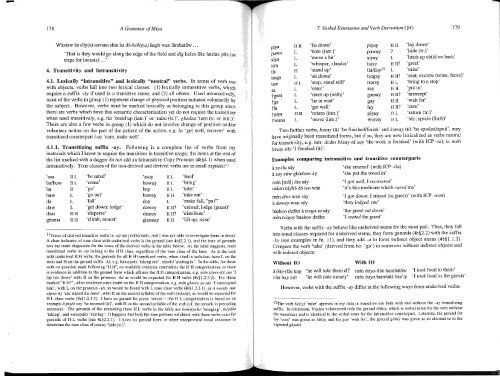A Grammar of Miya - UCLA Department of Linguistics
A Grammar of Miya - UCLA Department of Linguistics
A Grammar of Miya - UCLA Department of Linguistics
Create successful ePaper yourself
Turn your PDF publications into a flip-book with our unique Google optimized e-Paper software.
178 A <strong>Grammar</strong> <strong>of</strong> <strong>Miya</strong><br />
Waataw aa GiyCa) aavona shin ka do 6e6iy(a) aagir wan lambatilw ...<br />
'That is they would go along the edge <strong>of</strong> the field and dig holes like latrine pits Cas<br />
traps for locusts) ... '<br />
4. Transitivity and Intransitivity<br />
4.1. Lexically "intransitive" and lexically "neutral" verbs. In terms <strong>of</strong> verb Use<br />
with objects, verbs fall into two lexical classes: (I) lexically intransitive verbs, which<br />
require a suffix -ay if used in a transitive sense, and (2) all others. Used intransitively,<br />
most <strong>of</strong> the verbs in group (I) represent change <strong>of</strong> physical position initiated voluntarily by<br />
the subject. However, verbs must be marked lexically as belonging to this group since<br />
there are verbs which have this semantic characterization yet do not require the transitizer<br />
when used transitively, e.g. tla 'stand up Cintr.)' or 'raise (tI.)', gh"dza 'turn (tr. or intI.)'.<br />
There are also a few verbs in group (I) which do not involve change <strong>of</strong> position and/or<br />
voluntary action on the part <strong>of</strong> the patient <strong>of</strong> the action, e.g. la 'get well, recover' with<br />
transitized counterpart l-ay 'cure, make well'.<br />
4.1.1. Transitizing suffix -ay. Following is a complete list <strong>of</strong> verbs from my<br />
materials which I know to require the transitizer in transitive usage; the items at the end <strong>of</strong><br />
the list marked with a dagger do not add an Intransitive Copy Pronoun C4:§4.1) when used<br />
intransitively. Tone classes <strong>of</strong> the non-derived and derived verbs are in small capitals: 11<br />
'gSg HL 'be sated' 'gsay HL 'feed'<br />
bo/buw HL 'come' buway HL 'bring'<br />
ba H 'go' bay HL 'take'<br />
baw L 'go out' baway HH 'take out'<br />
da L 'fall' day L 'make faIl, "put'''<br />
daw L 'get down; lodge' daway HH? 'unload; lodge (guest)'<br />
dzar HH 'disperse' dzaray HH? 'disttibute'<br />
ghoma HH 'climb, mount' ghomay HH 'lift up, raise'<br />
IITones <strong>of</strong> derived transitive verbs in -ay are problematic, and I was not able to investigate them in detail.<br />
A clear indicator <strong>of</strong> tone class with underived verbs is the gerund (see 4:§2.2.1), and the tone <strong>of</strong> gerunds<br />
was my main diagnostic for the tones <strong>of</strong> the derived verbs in the table below. As the table suggests, most<br />
transitized verbs in -ay belong to the H H class, regardless <strong>of</strong> the tone class <strong>of</strong> the base. As is the case<br />
with underived H H verbs, the gerunds for all H H transitized verbs, when cited in isolation, have L on the<br />
stem and H on the gerund suffix -kg, e.g. bawayakg 'taking out', zityakj 'putting in'. In the table, for those<br />
with no question mark following "H H", no available evidence contradicts the H H categorization, or there<br />
is evidence in addition to the gerund form which affirms the H H categorization, e.g. min plyee-tId say 'I<br />
lay her down' with H on the pronoun -tId as would be expected for H H verbs (4:§1.2.3.2). For those<br />
marked "H H?", other evidence casts doubt on the H H categorization, e.g. min g;mwy-ya sdy 'I intercepted<br />
him', with L on the pronoun -yii, as would be found with L tone class verbs (4:§ 1.2.3.1), or it wundy suw<br />
sapan-dy 'she stirred the tuwo', with H on the second syllable <strong>of</strong> the verb (wundy), as would be expected for<br />
HL class verbs (4:§1.2.3.3). I have no gerund for piyay 'return'-the H L categorization is based on an<br />
example it piyee say 'he returned (it)" with H on the second syllable <strong>of</strong> the verb (cf. the remark in preceding<br />
sentence). The gerunds <strong>of</strong> the remaining three H L verbs in the table are buwdyaka 'bringing', bdydk
















